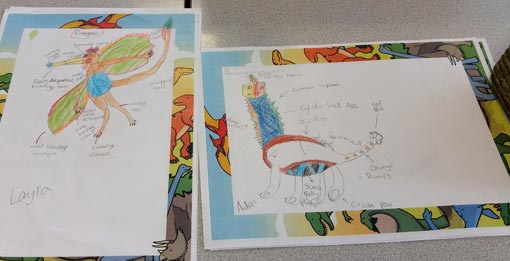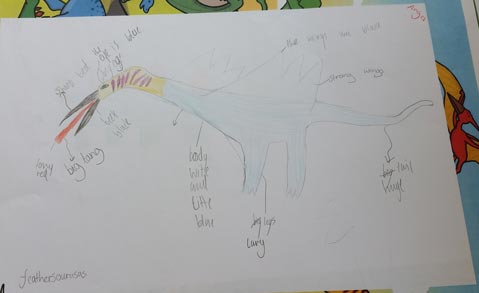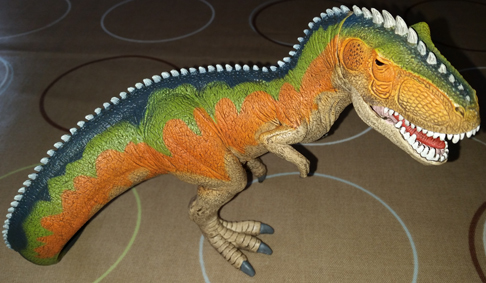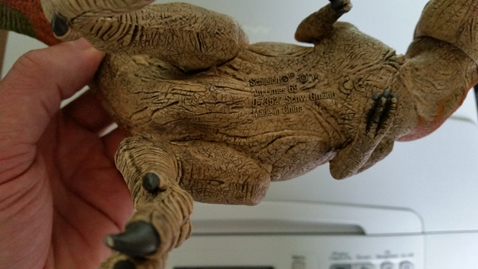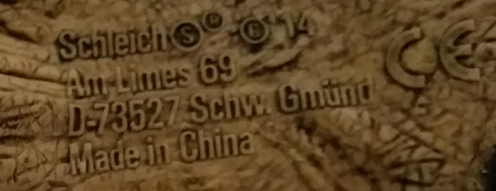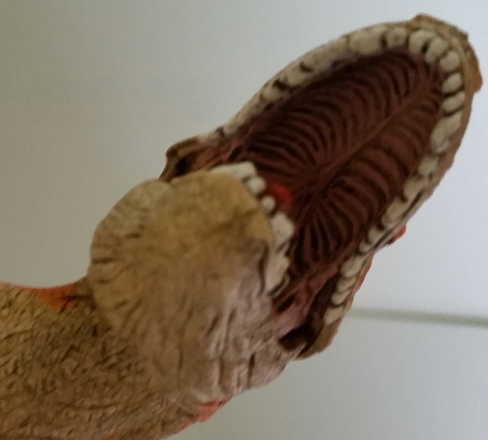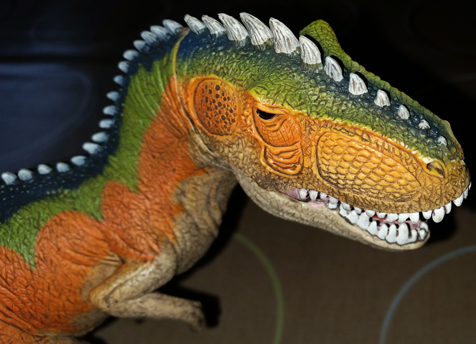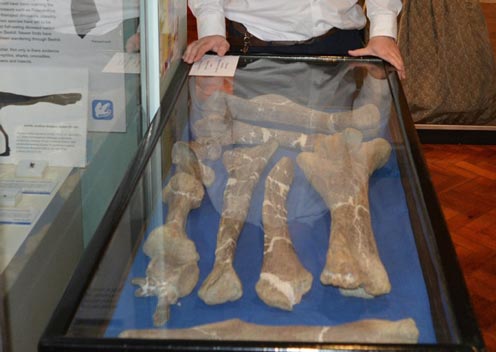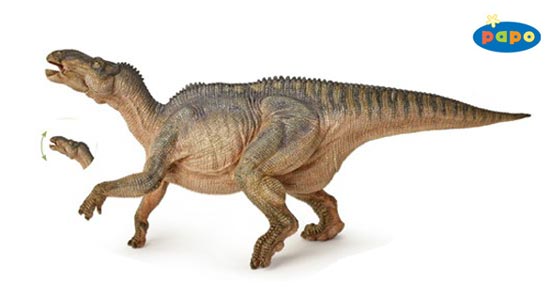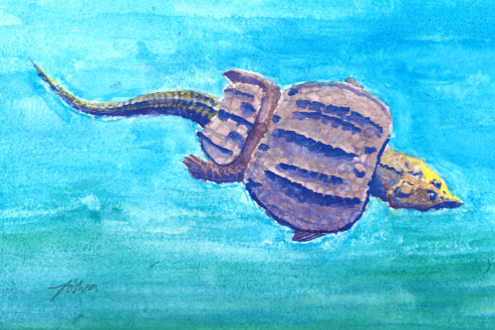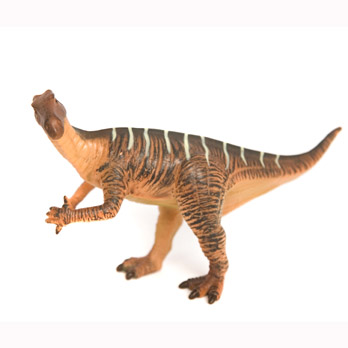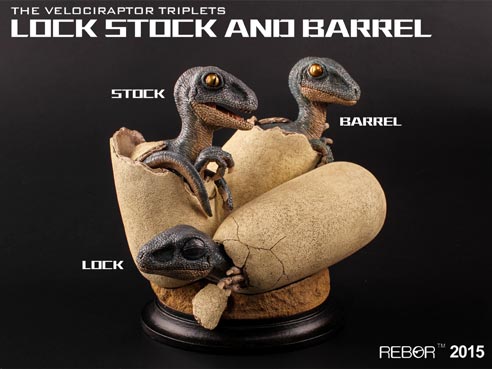Biologist Provides Fresh Insight into Early Cretaceous Dinosaur Tracks
Many of us, will this summer, go for a stroll along the beach whilst on a visit to the seaside. It seems this pastime may have been popular with theropod dinosaurs too. Biologist Pernille Venø Troelsen of the University of Southern Denmark, has provided a fresh perspective on a set of fossilised dinosaur tracks, part of an extensive set of dinosaur trackways uncovered in Lower Cretaceous sediments at Münchehagen, twenty miles northwest of the city of Hanover (Germany). The scientific paper on these footprints formed part of her Masters degree.
Meat-Eating Dinosaur Tracks
The exposed strata forms part of the Bückeberg Formation, which in turn is part of the Lower Saxony basin of northern Germany and the eastern Netherlands. The rocks laid down represent sandstones and silts in a brackish environment as this part of Europe during the Early Cretaceous (Berriasian to Valanginian faunal stages), was on the coast of a shallow, tropical sea, which stretched up into the Arctic circle and covered most of what is now Germany, the Low Countries and parts of France.
The footprints have been dated to around 142 million years ago (Early Cretaceous) and they represent tracks made by a large theropod dinosaur and a second, much smaller theropod.
An Illustration of a Typical Theropod Dinosaur
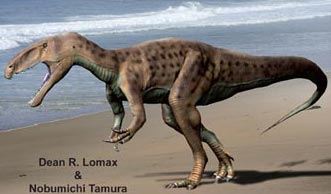
The image above comes from the excellent “Dinosaurs of the British Isles” book.
Picture credit: Nobumichi Tamura
The image of a theropod dinosaur strolling along a beach is from the front cover of the highly informative “Dinosaurs of the British Isles” by Dean Lomax and Nobumichi Tamura.
More details about this dinosaur book can be found here: Siri Scientific Press.
Hundreds of Dinosaur Tracks
Although many hundreds of dinosaur footprints have been uncovered in this part of northern Germany, for Pernille, these tracks give her the opportunity to infer aspects of dinosaur behaviour, that many people might not associate with ferocious predatory dinosaurs. For example, the theropods were ambling along, seemingly in no hurry. The impressions made in the wet sand and now fossilised preserve a tiny fragment of life in the Early Cretaceous, from time to time, the dinosaurs skid on the wet sand and these slips and skids have been preserved in the sandstone.
The larger of the two meat-eaters, stood around 1.6 metres high at the hips, the smaller animal had hips that were around 1.1 metres high. Hip height can be calculated by measuring the stride length of each dinosaur. Both dinosaurs are moving in a south-easterly direction.
Mapping Dinosaur Footprints (Early Cretaceous Dinosaur Trackways)
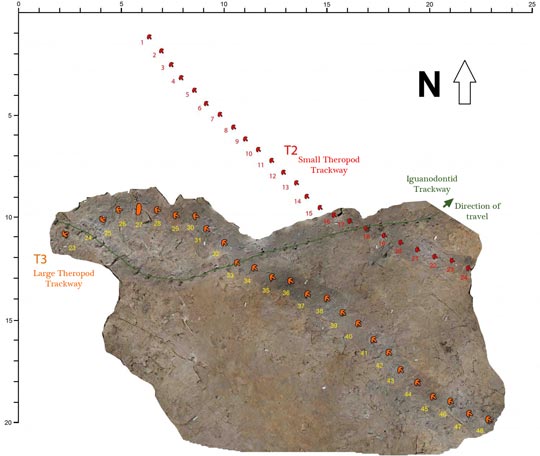
T3 is the large theropod track, T2 represents the smaller theropod. The iguanodontid track is highlighted in green.
Picture credit: Pernille Venø Troelsen (University of Southern Denmark) with additional annotation by Everything Dinosaur
In the picture above, the tracks of the large theropod (T3) are highlighted in orange. The smaller theropod (T2) is in red. Each footprint has been numbered, more than fifty individual footprints were included in the study under taken by Penille Venø Troelsen. Her interpretation of the inferred behaviours was presented at the thirteenth annual meeting of the European Association of Vertebrate Palaeontologists, last month, in Opole, Poland. The paper was presented to the conference on the 10th of July.
Different Types of Dinosaur Represented
At some point, a large ornithopod, probably an iguanodontid wandered across the beach. The trackway has been mapped onto the photograph above by Everything Dinosaur team members and the direction of travel noted. It is not known whether this big, plant-eating dinosaur walked over the beach, before or after the theropods. No interaction between the herbivore and the theropods is inferred.
Trace fossils such as dinosaur footprints provide evidence of the activity of organisms. Unlike body fossils, in which the carcase of an animal might be transported many miles after death (by river currents for example), most trace fossils show direct, in situ evidence of the environment at the time and the place where the animal lived.
If you were to step into the footprints made by these dinosaurs you would be literally “walking with dinosaurs”, but for the sake of preservation we would urge readers not to do this should the opportunity arise (take a photograph instead).
Important Information Obtained from the Meat-eating Dinosaur Tracks
From a biologist’s perspective a lot of information can be obtained from such an extensive set of tracks. Behaviour can also be inferred. The average speed of the large theropod has been calculated at around 6.3 km/hour, a comfortable walking pace for most people. The lighter, smaller theropod was travelling on average, a little faster, around 9.7 km/hour. The footprints were first uncovered in 2009, they are part of a series of Early Cretaceous dinosaur tracks and individual footprints found in this part of Germany, more than 200 individual prints have been mapped to date.
The smaller theropod occasionally crossed its legs as it trotted across the sand. Pernille puts forward a number of possible explanations for this, perhaps the little dinosaur got buffeted by a strong inshore breeze or perhaps it had found something to eat or was snapping at an insect that was bothering it.
There is another intriguing possibility. For a biologist, these two tracks could have been made a the same time, that is, this was a large dinosaur and a smaller dinosaur, possible the same species moving together. Could these be the tracks of a mother and its young?
Pernille Venø Troelsen suggested:
“As a biologist, I can contribute with knowledge about behaviour of individual animals. If so, this may illustrate two social animals, perhaps a parent and its young.”
Social Dinosaurs
There is an increasing amount of fossil evidence to suggest that dinosaurs were social animals that they exhibited complex behaviours. For example, a number of dinosaur nest sites have been discovered indicating that many different types of dinosaur nested in colonies, just like many species of birds do today. Other fossil evidence such as extensive trackways show that dinosaurs moved in herds and that these herds had a structure, adult animals moving on the outskirts of the group to protect the juveniles who were clustered towards the centre of the herd.
False Colour Image of One of the Smaller Theropod Dinosaur’s Footprints
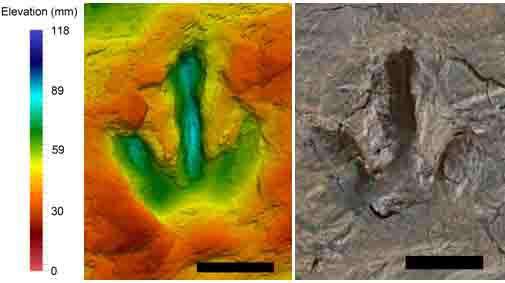
The different colours signify different depths of the footprint.
Picture credit: Pernille Venø Troelsen
The picture above shows a false colour image of one of the smaller theropod dinosaur’s tracks. The different colours illustrate the depth of various parts of the footprint.
Commenting on the study, a spokesperson from Everything Dinosaur stated:
“It is intriguing to think of these footprints representing an adult and juvenile dinosaur moving together, exploring the beach, perhaps looking out for any unfortunate animals that may have been stranded. Or maybe moving along the open beach was easier than having to make progress through the surrounding woodland and scrub.”
The spokesperson added:
“Many large animals today, use beaches as natural highways, however, as far as we understand, it is not possible to state with any degree of certainty that these two separate tracks were made at the same time. Given the parallel nature of the trackways and their relative sizes we can understand why the adult and juvenile dinosaur scenario has been inferred.”
Identifying the Species
As for the species of theropod, the lack of any body fossils found in association with the tracks prevents any identification being made. In these cases, when an organism is known from just trace fossils, an ichnogenus is erected, that is, any animal known from just trace fossils such as burrows, coprolites or in this case footprints.
For models and replicas of Early Cretaceous dinosaurs and other prehistoric animals: Wild Safari Prehistoric World Models.
The tracks of the meat-eating dinosaurs have both been assigned to the ichnogenus Megalosauripus (Megalosauripus maximus). However, whether these fossils were made by megalosaurid theropods remains open to debate, just like the dinosaur genus Megalosaurus, the ichnogenus Megalosauripus is a bit of a taxonomic waste basket when it comes to large, tridactyl theropod tracks found in Europe.
Everything Dinosaur acknowledges the help of the University of Southern Denmark in the compilation of this article.


